SUBHEAD: Community plans for transformation to a true Garden Island.
By Kenoe Kealoha on 29 April 2009 for Malama Kauai -
(www.malamaKauai.org)

Image above: Detail of "The Rebuke of Adam and Eve (1626) by Domenico Zampieri (Domenichino), the Italian Baroque era painter. From http://en.wikipedia.org/wiki/Domenichino
The agricultural community convened a Forum on April 4 to network, revisit past agricultural plans, and begin to identify priority goals and actions. Following a panel discussion of local agricultural leaders and a group brainstorm of the many challenges facing agriculture, break-out groups organized in eleven sectors to identify priority goals.
The goals identified are listed below, and a complete record of forum notes, including all input on challenges and goals, is available online at KauaiAgriculturalForum.Org Please use this website to highlight your own group or project and to connect with others that are interested in the agricultural future of the island. The purpose of the Forum is to support existing groups and blossom new initiatives through networking, collaboration, and planning. This is a community effort, and all are welcome to participate.
Available online now are past agricultural plans and other important documents, notes from the April 4 Forum, networking and blogging tools, a listing of Farmers Markets and CSAs, important links, and information about many existing projects, including contact information to get involved.
The priority goals listed below reflect the diverse opinions and contributions of the many stakeholders that attended the Forum, and additional information will be incorporated into the process of updating the island’s Agricultural Plan. Information from past plans and workshops, industry white papers, agricultural data, and other published literature related to food production on Kaua`i will be compiled to inform a more complete review of the current agricultural situation on the island.
Stakeholder interviews will also contribute significantly to the planning process. Malama Kaua`i has already begun this phase, interviewing over 20 farmers on the North Shore, as well as restaurateurs, grocers, and others involved in the local food chain. A summary of findings so far is available online.
The purpose of compiling information and conducting interviews is not to create “another” plan that is difficult to implement. The goals of this process are to:
Strategic Goals Identified by Working Groups
Action-Step Categories
ABBREVIATION APPENDIX FOR FOLLOWING MATERIAL
WATER
2) Support existing and establish new watershed councils with local control, funding, and resources (adopt Oregon State Law). (PS, PC, CO)
3) Initiate a Water Kuleana Rights Summit (precluded by a task force to identify and unify agencies, stakeholders, landowners, councils, and their rights and responsibilities). (CO)
4) Initiate (and pass) a water conservation and restoration legislative package; include grey water, composting toilets, water catchment, ditch system restoration, water quality, no petroleum dependence for water delivery. (PS, PC)
5) Education: call for action – all persons should attend at least one watershed council meeting. (E)
6) Determine the island’s and each watershed’s “carrying capacity”. (R)
LAND
2) Increase land access and availability by creating an ad hoc committee to identify potential areas for ag parks, community gardens, demonstration sites, and agro forestry. Incorporate a land acquisition discussion including private, state and county land-holders, and potential benefits (tax breaks, functioning watershed, ecosystem health). (CO)
3) Soil restoration and erosion control with a focus on locally-produced inputs. (E, BO)
LABOR
2) Create training programs for new farmers and scholarship / subsidized tuition opportunities for these programs. (IC)
3) Establish islandwide WWOOF (or similar program) – network with national and international models that make labor more available and affordable. (CO)
4) Involve, educate, and motivate young people. (Also need to assist them with start-up funds / land). (E, IC, CO)
CAPITAL / FINANCING
3) Identify how much money is needed to fund a sustainable agricultural system. (R)
4) Put pressure on banks to provide more funding for ag. (IC)
CROPS / COMMODITIES
2) Support and expand seed saving efforts, including seed exchanges, seed banks, and education. (CO, BO)
3) Increase research for small-scale and diversified ag. (IC, R)
4) Develop a local feed system (crop) for livestock. (BO, R, IN)
5) Demonstrate integrated systems – plants, animals and aquaculture. (E)
6) Secure on-island resources for inputs. (BO, R)
7) Increase research on and production of Hawaiian and Pacific Island crops. (IC, R, BO)
MARKETING
3) Connect farmers to the web and technology. (E)
4) Farm tours and other eco/ag-tourism. (BO)
DISTRIBUTION
1) Develop facilities for treatment, processing, packing, and distribution, including: (IN, BO, R)
4) Hold an annual Barter Fair. (CO)5) Develop a “one-stop-shop” ag economic web tool with Craigslist functionality. (CO)
PESTS / DISEASE / INVASIVE SPECIES
1) Tap into existing infrastructure (under KISS) to create a task force for ag, similar to what the landscape community has been doing. (CO)
2) Prevention: (E, PS)
4) Education: (E)
3) Utilize bio-remediation to manage difficult / high impact materials (petroleum based hazardous waste, biosolids, food process waste, etc.). (E, PC)
4) Develop a recycling / re-manufacturing facility to produce local building materials out of the applicable resins and recycle anything else. (IN)
5) Develop cooperative programs to provide organic waste as a feedstock for cattle and other livestock, and to utilize livestock to assist farmers in land clearing and land management efforts. (CO, BO)
6) Increase the use of composting worms and small-scale vermicomposting. (E)
RESEARCH AND EDUCATION
3) Public education and community outreach on the health and economic benefits of backyard gardening. (E)
4) Integrate different systems of knowledge into research and education – cultural knowledge is foundational. (IC)
LEGISLATIVE OBJECTIVES
General Priorities:
See also:
Island Breath: Is Sustainable Agriculture an Oxymoron? 8/31/06
Island Breath: TGI#3 Eden's Garden 4/19/07
Island Breath: TGI#16 Kauai Land Use Plan 11/1/07
Island Breath: Kauai Reforestation Plan 12/20/09
By Kenoe Kealoha on 29 April 2009 for Malama Kauai -
(www.malamaKauai.org)

Image above: Detail of "The Rebuke of Adam and Eve (1626) by Domenico Zampieri (Domenichino), the Italian Baroque era painter. From http://en.wikipedia.org/wiki/Domenichino
The agricultural community convened a Forum on April 4 to network, revisit past agricultural plans, and begin to identify priority goals and actions. Following a panel discussion of local agricultural leaders and a group brainstorm of the many challenges facing agriculture, break-out groups organized in eleven sectors to identify priority goals.
The goals identified are listed below, and a complete record of forum notes, including all input on challenges and goals, is available online at KauaiAgriculturalForum.Org Please use this website to highlight your own group or project and to connect with others that are interested in the agricultural future of the island. The purpose of the Forum is to support existing groups and blossom new initiatives through networking, collaboration, and planning. This is a community effort, and all are welcome to participate.
Available online now are past agricultural plans and other important documents, notes from the April 4 Forum, networking and blogging tools, a listing of Farmers Markets and CSAs, important links, and information about many existing projects, including contact information to get involved.
The priority goals listed below reflect the diverse opinions and contributions of the many stakeholders that attended the Forum, and additional information will be incorporated into the process of updating the island’s Agricultural Plan. Information from past plans and workshops, industry white papers, agricultural data, and other published literature related to food production on Kaua`i will be compiled to inform a more complete review of the current agricultural situation on the island.
Stakeholder interviews will also contribute significantly to the planning process. Malama Kaua`i has already begun this phase, interviewing over 20 farmers on the North Shore, as well as restaurateurs, grocers, and others involved in the local food chain. A summary of findings so far is available online.
The purpose of compiling information and conducting interviews is not to create “another” plan that is difficult to implement. The goals of this process are to:
1. Identify and prioritize strategic goals for increasing food production on Kaua`i.
2. Outline projects, initiatives, and groups whose efforts contribute to meeting strategic goals, as well as “leverage points” where action is needed.
3. Enhance communication and networking opportunities among the projects, initiatives, and groups within the agricultural community.
4. Develop a means for individuals to access reliable information online and get involved with existing projects, initiatives, and groups.
5. Catalyze action based on reliable information in the private sector, from the grassroots community level, and from policy-makers.
Mahalo to all of the sponsors that made the Kaua`i Agricultural Forum on April 4 possible, including Common Ground, County of Kaua`i – Office of Economic Development, Garden Island Resource Conservation and Development, Mālama Kaua`i, Permaculture Kaua`i, and Rapozo Kama`āina Fund. Special thanks to Sandy Hernon, Your Chef On Kaua`i, and her team of volunteers, as well as the many farmers that contributed to a delicious all-local lunch.
Contact: Andrea Brower andrea@malamakauai.orgKauaiAgriculturalForum.Org
Strategic Goals Identified by Working Groups
*These goals were provided by working groups, and do not necessarily reflect theviews and opinions of event organizers or other participants. They are not listedby priority.**Goals may overlap. Sectors will be more clearly defined in subsequent planning documents.
Action-Step Categories
To better understand what the next steps to realizing each goal are, they have been assigned one or more action categories. This is an imperfect system, and is simply a tool to begin to understand what next steps are needed. Nothing noted here is determinate.
ABBREVIATION APPENDIX FOR FOLLOWING MATERIAL
Policy County (PC) – Primary action involves county level policy change.
Policy State (PS) – Primary action involves state level policy change.
Community Organizing (CO) – Initial steps require organizing. May include establishing committees or groups, gathering stakeholders, creating better communication channels, or increasing community support for existing projects.
Infrastructure (IN) – Primary action requires major infrastructural changes or improvements.
Business Opportunity (BO) – Private sector opportunities exist.
Research (R) – Initial steps require that research be conducted (does not include changes in research institutions).
Education (E) – Involves general public education and awareness-raising (does not include systematic changes in educational institutions – see IC).
Institutional Change (IC) – Meeting this goal requires changes to an institution, such as Educational and Research Institutions or Financial Institutions. Willing Workers on Organic Farms (WWOOF) - Informal volunteer, apprentice, and internship arrangement to provide workers in alternative food production. [Added by Editor].
WATER
Priority goals:
1) Upgrade and maintain important irrigation systems. (IC, PS, PC)
2) Support existing and establish new watershed councils with local control, funding, and resources (adopt Oregon State Law). (PS, PC, CO)
3) Initiate a Water Kuleana Rights Summit (precluded by a task force to identify and unify agencies, stakeholders, landowners, councils, and their rights and responsibilities). (CO)
4) Initiate (and pass) a water conservation and restoration legislative package; include grey water, composting toilets, water catchment, ditch system restoration, water quality, no petroleum dependence for water delivery. (PS, PC)
5) Education: call for action – all persons should attend at least one watershed council meeting. (E)
6) Determine the island’s and each watershed’s “carrying capacity”. (R)
LAND
Priority Goals:
1) Protect and preserve best agricultural lands, and use the Important Agricultural Lands Study as a vehicle to compile data, engage the community, and revisit laws based on identified goals. (PC, PS)
2) Increase land access and availability by creating an ad hoc committee to identify potential areas for ag parks, community gardens, demonstration sites, and agro forestry. Incorporate a land acquisition discussion including private, state and county land-holders, and potential benefits (tax breaks, functioning watershed, ecosystem health). (CO)
3) Soil restoration and erosion control with a focus on locally-produced inputs. (E, BO)
LABOR
Priority Goals:
1) Formulate parameters and definitions for worker housing and pass necessary legislation (bringing down cost of living for farm workers). (PC)
2) Create training programs for new farmers and scholarship / subsidized tuition opportunities for these programs. (IC)
3) Establish islandwide WWOOF (or similar program) – network with national and international models that make labor more available and affordable. (CO)
4) Involve, educate, and motivate young people. (Also need to assist them with start-up funds / land). (E, IC, CO)
CAPITAL / FINANCING
Priority Goals:
1) Create a local investment opportunity office: (BO)
• Look for talent• Look for investors• Link to for or expand enterprises
2) Expand technical assistance for grant and loan applications, business plans and creative financing. (IC)
3) Identify how much money is needed to fund a sustainable agricultural system. (R)
4) Put pressure on banks to provide more funding for ag. (IC)
CROPS / COMMODITIES
Priority Goals:
1) Increase crop research on new and existing crops, including demonstration projects, crop potential studies, and cost of production analyses. Communication barriers between farmers and universities / research institutions need to be overcome for research to be executed properly. (IC, R)
2) Support and expand seed saving efforts, including seed exchanges, seed banks, and education. (CO, BO)
3) Increase research for small-scale and diversified ag. (IC, R)
4) Develop a local feed system (crop) for livestock. (BO, R, IN)
5) Demonstrate integrated systems – plants, animals and aquaculture. (E)
6) Secure on-island resources for inputs. (BO, R)
7) Increase research on and production of Hawaiian and Pacific Island crops. (IC, R, BO)
MARKETING
Priority Goals:
1) Branding and education / promotion: (CO, E)• Enhance “Kaua`i Grown” and other local-product awareness programs
• Use County Farm Fair to educate the public
• Increase usage of print media
• Create public service announcements and utilize other media outlets.
2) Establish a clear market management and business training program. (IC)
3) Connect farmers to the web and technology. (E)
4) Farm tours and other eco/ag-tourism. (BO)
DISTRIBUTION
Priority Goals:
1) Develop facilities for treatment, processing, packing, and distribution, including: (IN, BO, R)
• Slaughter house
• Dehydration facility
• Papaya de-infestation plant
• Pasteurization; community commercial kitchens; mobile processing
2) Establish cooperative efforts / resource for: (CO, BO)
• Shipping, transportation, marketing, insurance / bonds
• Labor, H2O, equipment, inputs, advertising, financial processing, health insurance, directories, bulk purchasing
• Coordinating marketing and distribution
3) Establish a permanent Farmers Market. (CO)
4) Hold an annual Barter Fair. (CO)5) Develop a “one-stop-shop” ag economic web tool with Craigslist functionality. (CO)
PESTS / DISEASE / INVASIVE SPECIES
Priority Goals:
1) Tap into existing infrastructure (under KISS) to create a task force for ag, similar to what the landscape community has been doing. (CO)
2) Prevention: (E, PS)
• Focus on buying local / producing locally
• Discourage imports and introductions
• Increase inspections (importers pay for inspections)
• Empower and educate farmers to prevent the spread of invasives through self-regulation and best management practice.
3) Management: (PS, E, CO)
• Support and secure funding for invasive species management on Kaua`i through coordinated effort of stakeholders / existing programs
• Establish farmer’s pledge program to prevent invasives
• Distribute and produce maps and materials specific to agricultural pests on Kaua`i (interactive online database)• Establish a position for a Kaua`i county environmental and ag liaison.
• Support and secure funding for invasive species management on Kaua`i through coordinated effort of stakeholders / existing programs
• Establish farmer’s pledge program to prevent invasives
• Distribute and produce maps and materials specific to agricultural pests on Kaua`i (interactive online database)• Establish a position for a Kaua`i county environmental and ag liaison.
4) Education: (E)
• Link buy local / Kaua`i-made campaign to invasive species prevention messages
• Provide ahupua`a based integrated pest management workshops for farmers and backyard gardeners
• Incorporate invasive species info into all ag education programs and events.
5) Early Detection: (CO, E)
• Establish communication network for reporting and rapid response specific to farming community
• Train farmers in early detection to identify priority species• Provide pest alerts as outbreaks occur that reach out to ag community.
WASTE / RESOURCE STREAM
Priority goals:
1) Recycle / Compost all organic waste (ban organics from the landfill). An integrated solution for Ag Industry, Businesses and Resorts, and Residents. (PC, IN, E, BO)
2) Develop decentralized, community based waste / resource management facilities (regeneration stations) to close the loop for neighborhoods, community gardens and small farms. (PC, IN, CO)
3) Utilize bio-remediation to manage difficult / high impact materials (petroleum based hazardous waste, biosolids, food process waste, etc.). (E, PC)
4) Develop a recycling / re-manufacturing facility to produce local building materials out of the applicable resins and recycle anything else. (IN)
5) Develop cooperative programs to provide organic waste as a feedstock for cattle and other livestock, and to utilize livestock to assist farmers in land clearing and land management efforts. (CO, BO)
6) Increase the use of composting worms and small-scale vermicomposting. (E)
RESEARCH AND EDUCATION
Priority goals:
1) Enhance K-12 educational programs: seed to table, ag in the classrooms, health and nutrition: (IC, E)
• After school programs and summer camps• Experiential learning – school gardens, field trips to farms, farmers as teachers• Integration of curriculum (ex – aquaculture as a life science topic).
2) Establish more opportunities for farmer training (including business training) and ongoing technical support and financing. (IC)
3) Public education and community outreach on the health and economic benefits of backyard gardening. (E)
4) Integrate different systems of knowledge into research and education – cultural knowledge is foundational. (IC)
LEGISLATIVE OBJECTIVES
Immediate Priority Goals:
1) Create citizen advisory council for Important Ag Lands project / study. (PC, CO)
2) Educate Department of Health officials on the safety of sustainable technologies such as composting, grey-water, and value-added processing. (E, PS)
3) Ensure the passage of a strong Farm Worker Housing bill. (PC)
General Priorities:
1) Planning / Zoning
• Important ag lands study (farmers input needed) (PC)• Update CZO (PC)• Sustainable overlay (follow model established by Canada) (PS, PC)•Moratorium on subdividing ag lands (PC)• Enforce farm dwelling agreement (PC)
2) Health
• Greywater recycling (PS, PC)• Composting toilets (PS, PC)• Water catchment (PS, PC)• Allow for the sale of Value-Added foods at Sunshine Farmers Markets (PC)
3) Building
• Local building materials (PS, PC)• Green building (PS, PC)• Farm worker housing (PC)4) Fiscal• Tax policies (5 acre min for ag dedication) (PS, PC)• Violation money – support ag (PS, PC)
• GE tax exemptions for “locally grown” (PS)
*COMMUNITY AND HOME GARDENING
1) To provide training to individuals, families and neighborhood/community organizations or businesses interested in learning the skills essential to prepare and manage a home or neighborhood garden.
2) To render such technical assistance as is essential in supporting the successful development and expansion of home and neighborhood gardens into an island-wide network of food production and distribution operations.
3) To recruit and employ successful farmers as the instructional staff of the Community Gardens Project and provide them with the training and support needed to render both instructional services and on-going technical support to the expanding network of community gardens.
4) To continue promoting, expanding and supporting the expansion of this gardening network into a viable supply of locally grown food of all kinds and varieties as a means of gradually achieving a suitable level of food self-sufficiency for Kauai's residents, businesses and visitors.
5) To develop such additional programs and projects as needed to support the educational, research, business and financial development of the Community Gardens Project as a major component in contributing to the sustainable of Kauai's treasured rural lifestyle.
* These goals are provided by the Community Gardens Project, sponsored by Kauai Community College and the Kauai Food Industry Forum, as many participants expressed the need to incorporate a sector specifically on Gardens. There was no break-out group at the April 4 Forum for this section.
See also:
Island Breath: Is Sustainable Agriculture an Oxymoron? 8/31/06
Island Breath: TGI#3 Eden's Garden 4/19/07
Island Breath: TGI#16 Kauai Land Use Plan 11/1/07
Island Breath: Kauai Reforestation Plan 12/20/09






